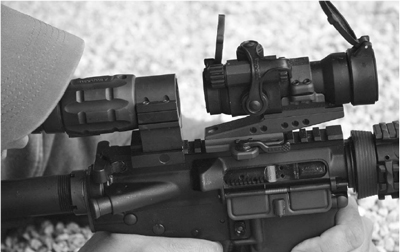At GunDigest, we independently review products. However, we may earn a commission when you purchase through links on our site. Learn More
AR-15 Scopes and Optics
AR-15 scopes are pretty simple; after all, you're just picking a scope for a rifle. Of course in the defensive, law-enforcement or military context, durability becomes much more important than in hunting.
Red-Dot Scopes

The beginning of red-dot scopes in practical competition began with Jerry Barnhart in 1990. He mounted an Aimpoint on a .38 Super Open gun and proceeded to win the Nationals with it.
Later that year, Doug Koenig, having mounted a red-dot scope on his Open gun, won the World Shoot. After that, there was no going back. Well, at least not for a few years.
The original scopes were dim, had narrow tubes and were quite fragile. It was not unheard of for a competitor to have two or three pre-zeroed scopes in their gear bag. Should one decide to break, they’d unbolt the old one and install the new one.
I recall one time, at a USPSA Nationals, after a hard rain the sun came out. My extensively-modified and unsealed scope fogged up. By holding a butane lighter flame against it, I was able to dry it out. We’ve come a long way since then, and Aimpoint has done a lot to advance the field.
The method of operation of any red-dot scope is the same: you look through it, at the target. For fast, close-in shooting, you simply let the dot “float” in your field of view. Where it is, is where you hit.
Optical purists quibble about which red-dots are and are not perfectly parallax-free. Parallax is the change in point of impact from the dot (or crosshairs) of a scope, when you move the dot or crosshairs from the optical center of the scope by moving your head.
A scope with parallax will have the point of impact away from the dot or crosshairs when they are near the edge of the field of view. In a magnifying optic, parallax can be a problem.
Optically, the magnifying scope can be adjusted so it is parallax-free at a single distance. However, the effect is so small at distance that scopes can be said to be “parallax-free” at or beyond a certain distance when properly adjusted.
Target competitors fuss over it greatly. A scope adjusted to be parallax-free at fifty yards will show parallax at 100, and vice-versa. When a change of fractions of an inch can mean lost points and lost matches, target shooters get fussy. The lack of magnification and the large dot size means that even a red-dot optic that is not well-engineered and has parallax hardly matters.
At worst, the parallax in a red-dot scope is not enough to move the point of impact out of the “shadow” of the dot. As one example, if the parallax error of a Brand-X red-dot scope is three-quarters of an inch at 100 yards, and the dot itself is 2MOA, then moving your head is not going to move the point of impact off of the dot. If the dot is on the target, you get a hit. And the parallax error may well be less than the accuracy limits of the ammo being used. So, the short explanation is: don’t sweat it.
If a manufacturer tells you their red-dot is parallax free, it probably is. And even if it isn’t, you aren’t going to miss your target because of it. At least not this side of 300 yards.
How red-dot sights work is also pretty much the same, with one big exception. Basically, a low-powered laser inside of the scope body reflects off of an internal plate that is partially-mirrored. The mirrored plate does not interfere with seeing through the scope. (But does explain why red-dot optics are often a bit dimmer than outside light.)
You see the dot. You aim with the dot. At close range you use binocular vision, let the dot “float” and get your hits. At distance you mentally focus, see only the view through the scope, and put your dot on your target.
The ability to look through an optic without seeing it is part of the “Bindon Aiming Concept.” The late Glyn Bindon figured out that a glowing dot against a black background was as good as transparent to the human brain when viewed with binocular vision. (Actually, our mind. Our brain is simply the mechanico-chemical processor of the thought processes of our sentience. But let’s not complicate things.)
By looking “through” an otherwise solid aiming device, you could shoot quickly and still be accurate. Even though you can look through most red-dot optics, your mind is following the same pattern that Glyn figured out.
Some competition shooters use this concept with magnifying optics. If they have a scope with a battery-powered or fiber optic enhanced aiming point, they will close the front scope cover on a magnifying scope.
The result is an opaque optic they can aim “through” using the Bindon Aiming Concept. They get both a magnifying optic when they want it, and a red-dot when they need it.
Next Step: Get your FREE Printable Target Pack
Enhance your shooting precision with our 62 MOA Targets, perfect for rifles and handguns. Crafted in collaboration with Storm Tactical for accuracy and versatility.
Subscribe to the Gun Digest email newsletter and get your downloadable target pack sent straight to your inbox. Stay updated with the latest firearms info in the industry.